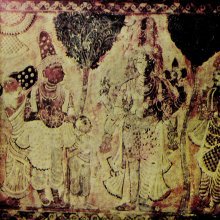Feeling: 1 definition
Introduction:
Feeling means something in Hinduism, Sanskrit. If you want to know the exact meaning, history, etymology or English translation of this term then check out the descriptions on this page. Add your comment or reference to a book if you want to contribute to this summary article.
Images (photo gallery)
(+1 more images available)
In Hinduism
Natyashastra (theatrics and dramaturgy)
Source: Shodhganga: Elements of Art and Architecture in the Trtiyakhanda of the Visnudharmottarapurana (natya)Feelings, Emotions and Expressions (in Sanskrit drama) are conveyed through Sātvikābhinaya, which represents one of the four divisions of Abhinaya or “ways to convey or represent one’s emotion to others” (in Sanskrit Drama), according to the Viṣṇudharmottarapurāṇa, an ancient Sanskrit text which (being encyclopedic in nature) deals with a variety of cultural topics such as arts, architecture, music, grammar and astronomy.—Sātvikābhinaya that deals with the feelings, emotions and expressions, conveyed by the actors. Flow of tears, horripilation, sweating, throbbing of heart and faultering speech come under the sātvikābhinaya. It is important to note here that in the Nāṭyaśāstra the word bhāvabyañjaka is used for the sātvikābhinaya. When the inner ideas of a dramatist are expressed by means of words, gestures, facial expressions and the representation of sattva, those are called bhāvas. [...]

Natyashastra (नाट्यशास्त्र, nāṭyaśāstra) refers to both the ancient Indian tradition (shastra) of performing arts, (natya—theatrics, drama, dance, music), as well as the name of a Sanskrit work dealing with these subjects. It also teaches the rules for composing Dramatic plays (nataka), construction and performance of Theater, and Poetic works (kavya).
See also (Relevant definitions)
Starts with: Feeling Happiness, Feeling Pain.
Ends with: Indifferent Feeling, Transitory feeling.
Full-text (+2644): Vedana, Asatavedaniya, Vidhana, Vyanjaka, Adhyatmikavedana, Bahyavedana, Caitasikivedana, Kayikivedana, Nirjitendriya, Caitasiki, Kayiki, Bahyayatana, Samgrihita, Sprishti, Manovritti, Antarbhavna, Cittavikara, Tiraskara, Nalavu, Nirduhkha.
Relevant text
Search found 470 books and stories containing Feeling; (plurals include: Feelings). You can also click to the full overview containing English textual excerpts. Below are direct links for the most relevant articles:
Dhyana in the Buddhist Literature (by Truong Thi Thuy La)
2.3: Mindfulness (b): The Contemplation on Feelings < [Chapter 2 - The Dhyāna as depicted in Hinayāna Literature]
2.3: Mindfulness (d): The Contemplation of Mental Objects (Dhamma) < [Chapter 2 - The Dhyāna as depicted in Hinayāna Literature]
4.3 (b): The Concentration Technique on the Breath < [Chapter 4 - The Practice of Dhyāna]
The Buddhist Path to Enlightenment (study) (by Dr Kala Acharya)
1.3.2. Vedanānupassanā–Contemplation of the Feeling < [Chapter 2 - Five Groups of Factor]
4.2.4. Faculty of Concentration (Samādhindriya or Samādhi) < [Chapter 2 - Five Groups of Factor]
1.2. The Four Foundations of Mindfulness (Introduction) < [Chapter 2 - Five Groups of Factor]
A History of Indian Philosophy Volume 1 (by Surendranath Dasgupta)
Part 9 - Feelings, the Ultimate Substances < [Chapter VII - The Kapila and the Pātañjala Sāṃkhya (yoga)]
Part 5 - The Khandhas < [Chapter V - Buddhist Philosophy]
Part 15 - Karma Theory < [Chapter VI - The Jaina Philosophy]
Cetasikas (by Nina van Gorkom)
Chapter 2 - Feeling < [Part I - The Universals]
Appendix 1 - Appendix To Chapter 2 < [Appendix And Glossary]
Chapter 6 - Concentration < [Part I - The Universals]
A Survey of Paramattha Dhammas (by Sujin Boriharnwanaket)
Chapter 19 - Feelings < [Part 2 - Citta]
Chapter 20 - Associated Dhammas < [Part 2 - Citta]
Chapter 22 - Sobhana And Asobhana < [Part 2 - Citta]
Related products
(+50 more products available)











